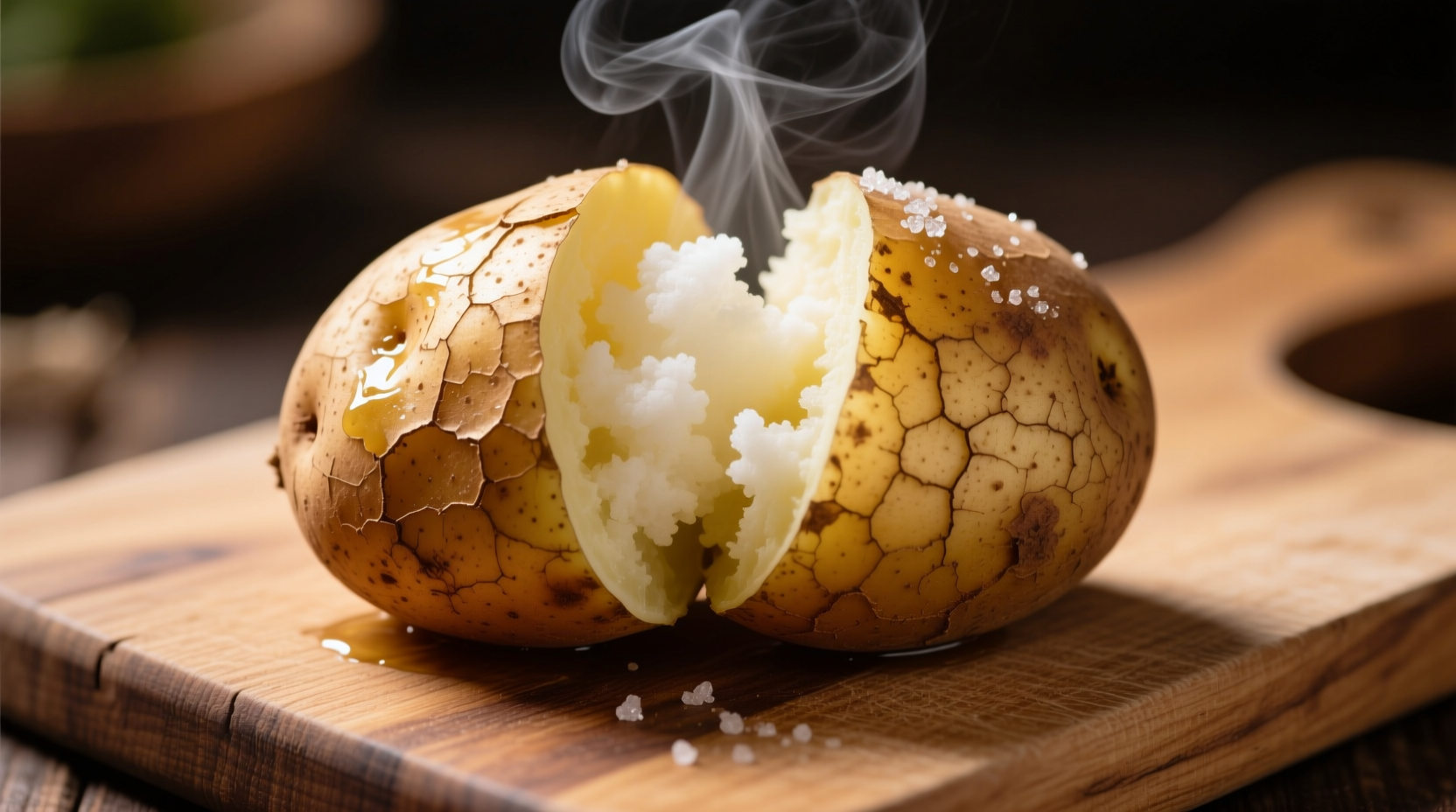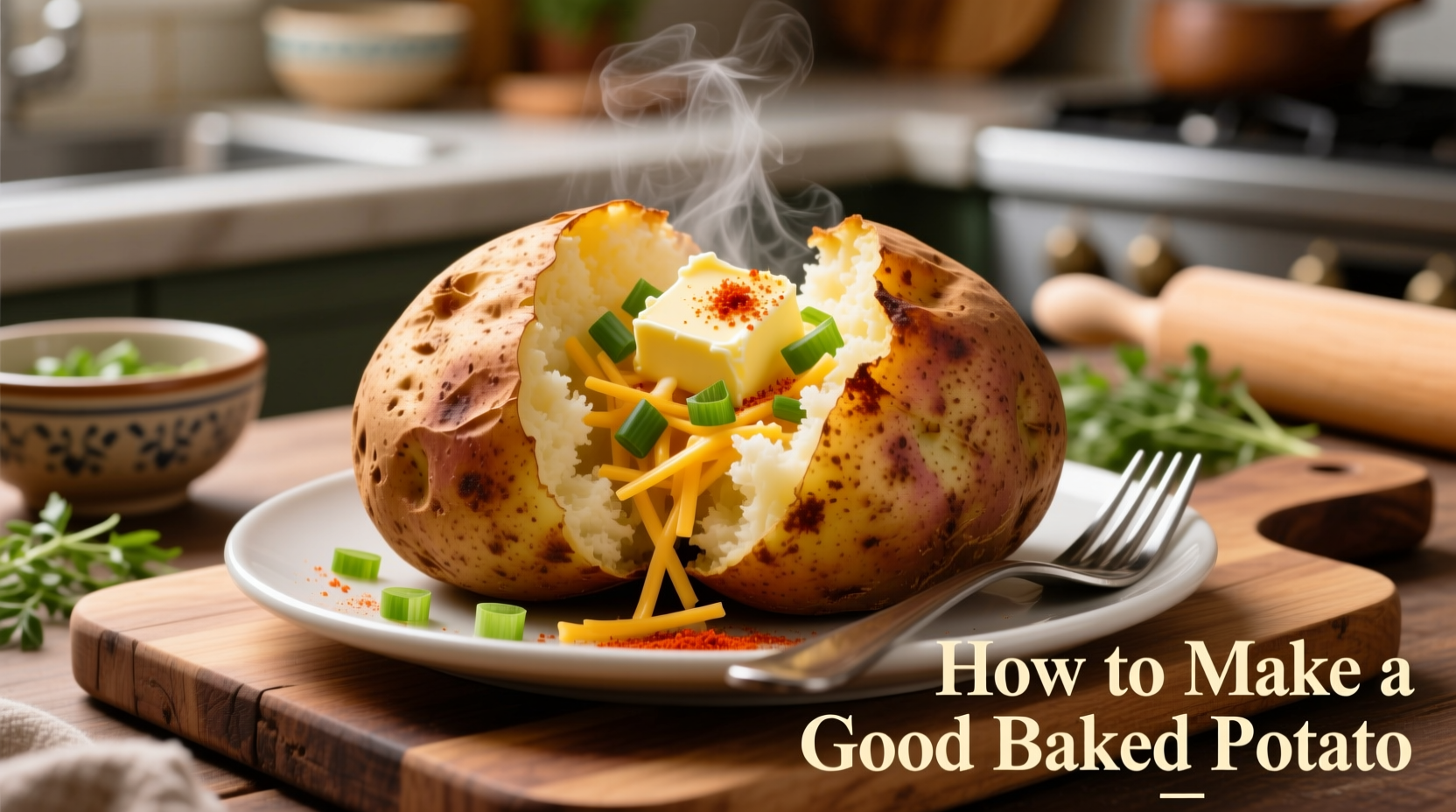The perfect baked potato requires russet potatoes, proper seasoning, and baking at 400°F (204°C) for 45-60 minutes until internal temperature reaches 205-210°F (96-99°C). Pricking the skin, rubbing with oil, and resting after baking creates crispy skin and fluffy interior every time.
Your Journey to the Perfect Baked Potato
Many home cooks struggle with soggy skins, uneven cooking, or dry interiors when baking potatoes. As a professional chef with years of experience teaching foundational cooking techniques, I've perfected a method that guarantees restaurant-quality results. This guide reveals the science-backed approach that transforms a simple potato into a culinary masterpiece.
Why Most Baked Potatoes Fail (And How to Avoid These Mistakes)
Before we dive into the perfect method, let's address common pitfalls. Most baked potatoes fail because of improper potato selection, incorrect temperature, or skipping critical preparation steps. The USDA recommends cooking potatoes to an internal temperature of 205-210°F (96-99°C) for optimal texture, yet many home cooks rely solely on time estimates without checking internal temperature.
| Potato Variety | Best For Baking? | Texture Result | Moisture Content |
|---|---|---|---|
| Russet (Idaho) | ★★★★★ | Fluffy, light interior | High starch, low moisture |
| Yukon Gold | ★★★☆☆ | Creamy, buttery texture | Moderate starch, higher moisture |
| Red Potatoes | ★☆☆☆☆ | Dense, waxy texture | Low starch, high moisture |
| Sweet Potatoes | ★★★★☆ | Moist, sweet interior | Very high moisture |
Step 1: Selecting and Preparing Your Potatoes
Choose medium to large russet potatoes of similar size for even cooking. The University of Idaho's Potato Research Center confirms that russets' high starch content creates the ideal fluffy texture when baked properly. Avoid refrigerating potatoes before baking, as cold temperatures convert starch to sugar, affecting both flavor and texture.
Wash potatoes thoroughly under cold water, scrubbing away any dirt. Pat completely dry with paper towels—moisture on the skin prevents crispiness. Using a fork, prick each potato 8-10 times to allow steam to escape during baking. This critical step prevents bursting and ensures even cooking.

Step 2: The Professional Seasoning Technique
Professional chefs know that seasoning isn't just about flavor—it affects texture too. Rub each potato with 1 teaspoon of olive oil or melted butter, ensuring complete coverage. The oil creates a barrier that helps the skin crisp while protecting the interior moisture.
Sprinkle generously with kosher salt (about 1/4 teaspoon per potato). The coarse salt crystals create tiny channels in the skin as they dissolve, enhancing crispiness. For extra flavor, add garlic powder or smoked paprika at this stage.
Step 3: Baking for Perfect Results
Preheat your oven to 400°F (204°C)—this higher temperature creates the ideal environment for crispy skin. Place potatoes directly on the middle oven rack with a baking sheet on the rack below to catch any drips.
For foolproof results, follow this temperature timeline:
| Time Elapsed | Internal Temperature | What's Happening | Action Required |
|---|---|---|---|
| 0-20 minutes | 130-160°F (54-71°C) | Starches beginning to gelatinize | None |
| 20-40 minutes | 160-190°F (71-88°C) | Major starch transformation occurring | Flip potatoes halfway |
| 40-60 minutes | 190-210°F (88-99°C) | Optimal texture achieved | Check for doneness |
Bake for 45-60 minutes (depending on size), flipping halfway through. The potatoes are done when a fork inserts easily into the center and the internal temperature reaches 205-210°F (96-99°C). This precise temperature range ensures maximum fluffiness without dryness.
Step 4: The Critical Resting Period
Remove potatoes from the oven and let them rest for 5-10 minutes. This resting period allows residual heat to finish cooking the interior while the skin continues crisping. Cutting too soon releases steam that should remain trapped inside, resulting in a less fluffy texture.
Step 5: Cutting and Serving Like a Pro
Make a horizontal slit around the circumference of each potato, then press the ends toward the center to open it up naturally. This technique creates the perfect vessel for toppings while maintaining structural integrity.
For classic preparation, add a pat of butter that melts into the fluffy interior, followed by a sprinkle of salt. Fluff the inside gently with a fork to incorporate the butter and create air pockets. Top with your favorite additions—sour cream, chives, bacon bits, or cheese all work beautifully.
Troubleshooting Common Baked Potato Problems
Soggy skin? Your oven temperature was too low or you skipped the oil rub. Next time, increase oven temperature to 425°F (218°C) and ensure thorough oil application.
Dry interior? You likely overcooked the potatoes or didn't let them rest properly. Always check internal temperature and allow the full resting period.
Uneven cooking? Potatoes were different sizes or you didn't flip them during baking. Use similarly sized potatoes and flip halfway through cooking.
Advanced Techniques for Culinary Excellence
For an extra-crispy skin, some professional kitchens use a two-stage baking method: start at 375°F (190°C) for 30 minutes, then increase to 425°F (218°C) for the final 15-20 minutes. This gradual approach prevents the exterior from drying out before the interior cooks through.
When time is limited, microwave potatoes for 5 minutes before finishing in the oven for 20-25 minutes. This hybrid method preserves the oven-baked texture while reducing total cooking time.
Storing and Reheating Leftovers
Cool completely before storing in an airtight container in the refrigerator for up to 4 days. To reheat without drying out, wrap in foil and bake at 350°F (177°C) for 15-20 minutes, or use the oven's convection setting for more even heating.
Frequently Asked Questions
Should I wrap potatoes in foil before baking? No—foil traps moisture, resulting in steamed rather than baked potatoes with less crispy skin. Professional chefs avoid foil for traditional baked potatoes.
Can I bake potatoes at a lower temperature for longer? While possible, lower temperatures (below 375°F/190°C) won't create the ideal crispy skin. The Maillard reaction that creates desirable browning occurs most effectively above 300°F (149°C).
Why do some recipes suggest baking potatoes on a bed of salt? The salt bed draws out excess moisture from the bottom of the potato, promoting even crisping on all sides. It also subtly seasons the skin during cooking.











 浙公网安备
33010002000092号
浙公网安备
33010002000092号 浙B2-20120091-4
浙B2-20120091-4